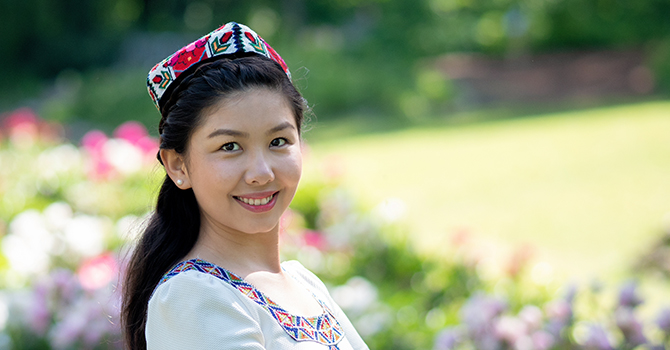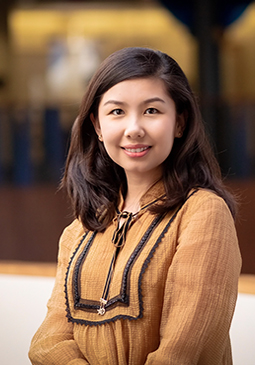Silk Road Native’s Dream Repeats with Every Intervention

Pahriya Ashrap
PhD Student in Environmental Health Sciences
My desire to pursue a career in public health has always been directly related to my desire to advocate for the health and well-being of my people.
I am a member of the Uyghur people, a large Turkic minority community in Central Asia. And my journey to public health began when I was fifteen. With a dream of making a positive impact on society, I joined a local Anti-Drug Abuse and AIDS Prevention Network to help slow the spread of AIDS in the region. As I traveled to rural villages, I saw poverty, pollution, a lack of quality health care services, and how all of that negatively impacted health. I saw people suffering from malnutrition, respiratory disease, and cancer due to water and air pollution, the results of excessive industrial mining and development. I also witnessed the devastating effects of AIDS on a population that had few means to address the epidemic.
These experiences got me interested in studying environmental science and pursuing a career in environmental health. Math and science had been my strongest subjects since I was young, and I focused on them in high school. My dream was beginning to take shape.
From “Harvard” to Harvard to Michigan
At Peking University in Beijing—often dubbed “China’s Harvard”—I majored in environmental sciences and joined a research lab that looked at how the human body processes toxic chemicals. I read as much as I could about toxicology—the harmful effects of chemicals on humans—and became especially interested in endocrine disruptors.
The more I read about diets and other chemical intakes, the more I knew public health was where I could best apply my fascination with and aptitude for environmental sciences to help people. The opportunity to study in the US seemed like a myth at the time, but I was accepted at Harvard University’s T. H. Chan School of Public Health, where I earned a master’s degree and continued research in toxicology.
You don’t just see diversity with your eyes, you feel it with all of your senses.
With myth now reality, I needed a place to call home for the long duration of a doctoral program. For hundreds of years, the Uyghur people were traders on the Silk Road. We exchanged goods, and in doing so, we exchanged cultures. I grew up surrounded by different people and languages. Uyghur lands cross many borders. We are an embracing, open, hospitable people, and it's just in my DNA that I embrace diversity.
You don’t just see diversity with your eyes, you feel it with all of your senses—how much people collaborate, how friendly they are, how open they are to new ideas. When I visited Michigan two years ago, I found it to be a truly diverse place. The professors are down-to-earth, approachable people. They collaborate all the time, with each other and with students. I knew almost immediately that I would be and feel included at Michigan. We have room to grow, of course, but we have constant, open dialogue about diversity here, and that is exciting to me.
Bridging Lab to Human
As a student researcher in Dr. John Meeker’s lab, we use epidemiology methods to explore environmental exposures in humans. We have a knowledge gap between disease causes and disease manifestation. Lab work using molecular and tissue samples is often too removed from the “real world” of a human body to give us a full picture of disease. In Dr. Meeker’s lab, we look at the same chemicals many others do, but we incorporate as much human data as possible from as many sources as possible.
 We are trying to build a bridge between diseases occurring in the human body and what
we see in the lab. Lab data is clean and clear. Data from living humans is messy,
because our samples come from uncontrolled sources. Methods from epidemiology and
biostatistics—like tracing diseases in a community and relying on sophisticated data
models—are the main tools we use to build that bridge. The bridge itself is our whole
process, all the critical thinking that goes into discovering the environmental sources
of human disease.
We are trying to build a bridge between diseases occurring in the human body and what
we see in the lab. Lab data is clean and clear. Data from living humans is messy,
because our samples come from uncontrolled sources. Methods from epidemiology and
biostatistics—like tracing diseases in a community and relying on sophisticated data
models—are the main tools we use to build that bridge. The bridge itself is our whole
process, all the critical thinking that goes into discovering the environmental sources
of human disease.
Communicating Science
A mentor once told me good scientists should be able to explain to their parents what they’re doing. Whenever I begin a new paper or project, I always attempt to explain it to my parents in less than three minutes. Because of these conversations, my parents know enough about what I do and why I do it to really appreciate the science itself and the significance it has for populations.
Communication must be a core part of doing science. We can produce studies and papers, but if it doesn’t affect practice and policy, we’ve fallen short.
Much of what I do touches daily human life—women’s health, pregnancy and birth, toxicity of personal care products. Communication must be a core part of doing science. We can produce studies and papers, but if it doesn’t affect practice and policy, we’ve fallen short. We can improve our language choices and our data translation. What does a 1.7 odds ratio mean and how does it impact someone’s health?
As a master’s student, I had the privilege of taking a class with Gina McCarthy, the former EPA administrator. The class totally blew my mind. We discussed how to move from science to policy to broader social impacts and how that can take years of effort. We expect policy people to do all the policy work, but we have to stand up and get involved as scientists. We should be the ones to push certain things forward. In most cases, we are closest not only to the data but to the people, communities, and environments involved with our research.
Mentoring Near and Far
Mentoring has become very important to me. It’s a way I give back for all the help I received on my journey. My dream of making an impact on society was just a dream until I came here, and so many people along the way have supported me. Everyone has been remarkably generous with their time and energy, so I want to do the same for others.
When I see people in need, I know it’s an opportunity to help.
I mentor some of our bachelor's and master’s students here at Michigan Public Health. And I connect home regularly with youth in the Uyghur community, from little kids to middle schoolers to college students. I regularly post math and science advice online to continue helping these students with academics. Sometimes they find my blog or my social media channels and ask me questions about how to study math and science or even how to prepare for the TOEFL or the GRE or where to begin with the visa process.
When I see people in need, I know it’s an opportunity to help. I always want helping people to be at the center of my life. Uyghurs, especially women, have overcome tremendous adversity. Whenever I can give back to this community and to any group of people in need—through reproductive health interventions or through online math help—then I know my dream is coming true.
